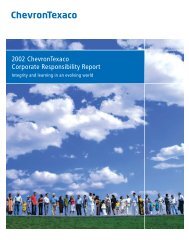Next* Magazine, Issue 5 - Chevron
Next* Magazine, Issue 5 - Chevron
Next* Magazine, Issue 5 - Chevron
Create successful ePaper yourself
Turn your PDF publications into a flip-book with our unique Google optimized e-Paper software.
Cautionary Statement Relevant to Forward-Looking Information for the Purpose of “Safe Harbor” Provisions of the Private Securities Litigation Reform Act of 1995.<br />
This publication of <strong>Chevron</strong> Corporation contains forward-looking statements relating to <strong>Chevron</strong>’s operations that are based on management’s current expectations, estimates and projections about the petroleum, chemicals and other energy-related industries. Words such as<br />
“anticipates,” “expects,” “intends,” “plans,” “targets,” “forecasts,” “projects,” “believes,” “seeks,” “schedules,” “estimates,” “budgets,” “outlooks” and similar expressions are intended to identify such forward-looking statements. These statements are not guarantees of future<br />
performance and are subject to certain risks, uncertainties and other factors, some of which are beyond the company’s control and are difficult to predict. Therefore, actual outcomes and results may differ materially from what is expressed or forecasted in such forward-looking<br />
statements. The reader should not place undue reliance on these forward-looking statements, which speak only as of the date of this publication. Unless legally required, <strong>Chevron</strong> undertakes no obligation to update publicly any forward-looking statements, whether as a result of new<br />
information, future events or otherwise.<br />
Among the important factors that could cause actual results to differ materially from those in the forward-looking statements are: changing crude oil and natural gas prices; changing refining, marketing and chemical margins; actions of competitors or regulators; timing of exploration<br />
expenses; timing of crude oil liftings; the competitiveness of alternate-energy sources or product substitutes; technological developments; the results of operations and financial condition of equity affiliates; the inability or failure of the company’s joint-venture partners to fund<br />
their share of operations and development activities; the potential failure to achieve expected net production from existing and future crude oil and natural gas development projects; potential delays in the development, construction or startup of planned projects; the potential<br />
disruption or interruption of the company’s net production or manufacturing facilities or delivery/transportation networks due to war, accidents, political events, civil unrest, severe weather or crude oil production quotas that might be imposed by the Organization of Petroleum<br />
Exporting Countries; the potential liability for remedial actions or assessments under existing or future environmental regulations and litigation; significant investment or product changes under existing or future environmental statutes, regulations and litigation; the potential liability<br />
resulting from other pending or future litigation; the company’s future acquisition or disposition of assets and gains and losses from asset dispositions or impairments; government-mandated sales, divestitures, recapitalizations, industry-specific taxes, changes in fiscal terms<br />
or restrictions on the scope of company operations; foreign currency movements compared with the U.S. dollar; the effects of changed accounting rules under generally accepted accounting principles promulgated by rule-setting bodies; and the factors set forth under the heading<br />
“Risk Factors” on pages 29 through 31 of the company’s 2011 Annual Report on Form 10-K. In addition, such results could be affected by general domestic and international economic and political conditions. Other unpredictable or unknown factors not discussed in this publication<br />
could also have material adverse effects on forward-looking statements.<br />
U.S. Securities and Exchange Commission (SEC) rules permit oil and gas companies to disclose only proved reserves in their filings with the SEC. Certain terms, such as “probable” or “possible” reserves, “potential” or “recoverable” volumes, “resources,” and “crude oil in place,”<br />
among others used in this publication, may not be permitted to be included in documents filed with the SEC. U.S. investors should refer to disclosures in <strong>Chevron</strong>’s Annual Report on Form 10-K for the year ended December 31, 2011.

















